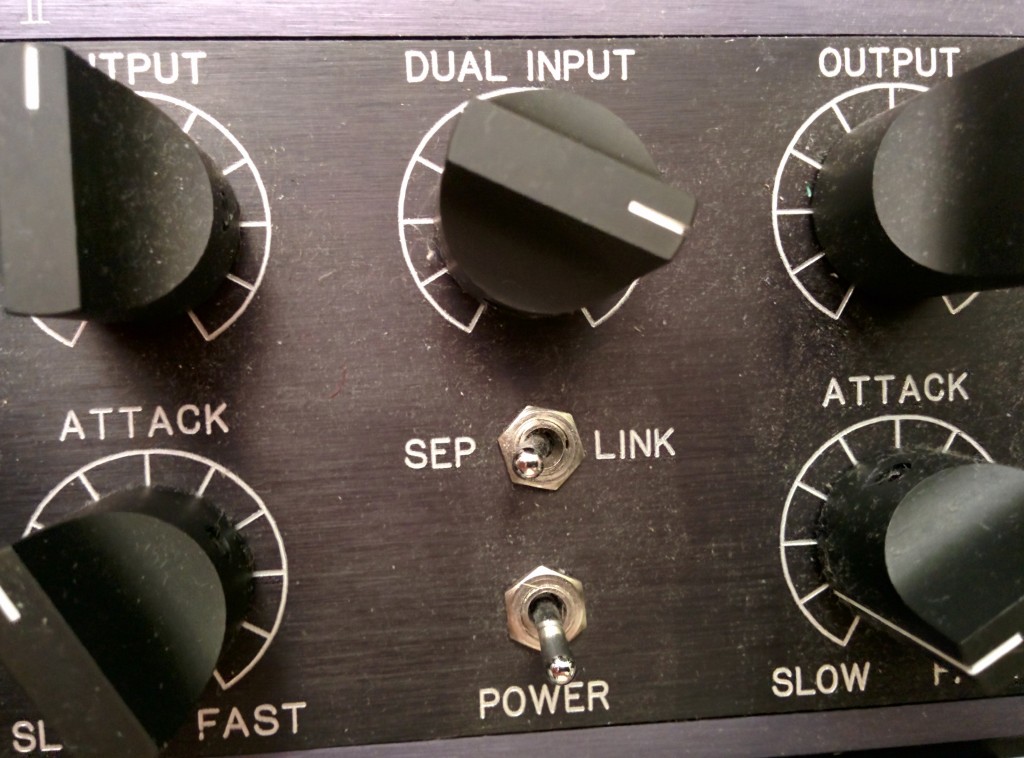From the picture above of my Manley Stereo Compressor, you can notice two things:
1) My Manley Variable Mu is dusty and would benefit from being cleaned.
2) It has a Separate/Link switch for two different stereo compression mode.
The last two days, I’ve been exchanging emails with Drew (Vancouver, Canada) regarding the following question: “Stereo Compression: Is it better Linked or Separated?”.
To answer this question, let’s consider few scenarios:
Case 1: Ideal Dual Mono Configuration (Sep)
You have two perfectly calibrated machine in parallel and you process your left and you right separately (in dual mono), that would technically be the perfect stereo compressor; as you pass a mix through it, and there is no surprise. The center stays at the center, and the side are compressed accordingly to what passes through it.
That’s actually how plugins work because digital is « perfect », at least in terms of calibration.
Case 2: Linked Mode
Stereo analog compressors often give you the option to go linked instead of separated, which kind of « sums both signals for its detector circuit ».
This is actually not always true. For compressors having individual controls for each channel, the link mode combines the gain reduction and make both GR equals. It basically applies the largest GR value of both compressors to both compressors. The manley vari-mu works that way in Linked mode. I can have two completely different settings on both sides and whatever GR value is higher at the moment is applied to both channels.
So, back to the case, you have a mix where there is a super loud Low Tom hit panned on the left side, and a soft string pad on the right side, a crazy gain reduction will be applied on both side. For the left side, it is the appropriate response: The huge tom hit is controlled. On the right side, however, the strings is damped by 6 db while it shouldn’t. This therefore creates an important artifact in the stereo image.
So why the stereo link option exist then, you will ask ?
Case 3: Less than ideal Dual Mono configuration
You have bought the same mono compressor twice, but at two different times, from two different suppliers. They are NOT matched pairs. One was last calibrated 3 years ago, the other one is fresh out of the box. The compressors do not have stepped controls. You want to compress a stereo mix. You will try to adjust both side at the same time, but hardly be able to match both sides exactly. From time to time, you feel the center is off a bit. You hear about the Stereo Link adapter, so you install it. Now you can just adjust the parameters on one side, and both compressor will apply the exact same GR on both sides; it’s easier and faster. Assuming your initial levels are matched, your center is back at the center. From time to time, a drum hits more on one side and the whole mix reacts weird, and the mix breath a bit less, but overall it’s so much better that you’re still happy with it. Then you go on a forum and tell everyone how stereo link is better than dual mono…
*Please note, that a Separate mode on a Stereo Compressor usually wouldn’t have this problem, as both channels are matched pairs. While processing the same mono signal through both channels of a stereo compressor, both mode should sound exactly the same for identical settings. If it does sounds different, that means your compressor needs calibrating/servicing. Linked mode can help to cover it up temporarily, but that comes to a price; a distorted stereo image and a mix that breathes less. It’s always better to have to identical machines.
Case 4: Dual Mono with different Left-Center-Right content
After the initial release of this article, it has been brought to me that I failed to mention another important consideration:
Using the same tom and string example, there would likely also be a vocal or lead instrument in the center. With separated stereo compression, the Tom side would get brought down and leave the string side at its original level (no nasty side effect in the strings), but the vocal in the center will appear to move to the string side. This is can be distracting and sometimes worse than having the string duck a little while maintaining the vocal in the center.
While this is absolutely true, I usually don’t personally hear it as a problem. Indeed, both linked and unlinked modes have uses, advantages and disadvantages, but I personally find that dual mono sound better all things considered.
Interestingly, many mastering engineers I know are thinking the same, while Mix engineers often seem to like them linked better. This is probably due to the fact that the dynamic range of the material as well as the amount of gain reduction applied on each is dramatically different when used as a mixbus compressor versus when used as a mastering compressor.
Overall, I think it is safe to affirm that linked will often sound closer to mono and contained (Center as a priority), while separated will tend to sound much more open and wider. At the end, it might also just be a question of taste, or a matter of affinity with the music genre (EDM and Hip Hop,versus Jazz, Rock and Alternative).

